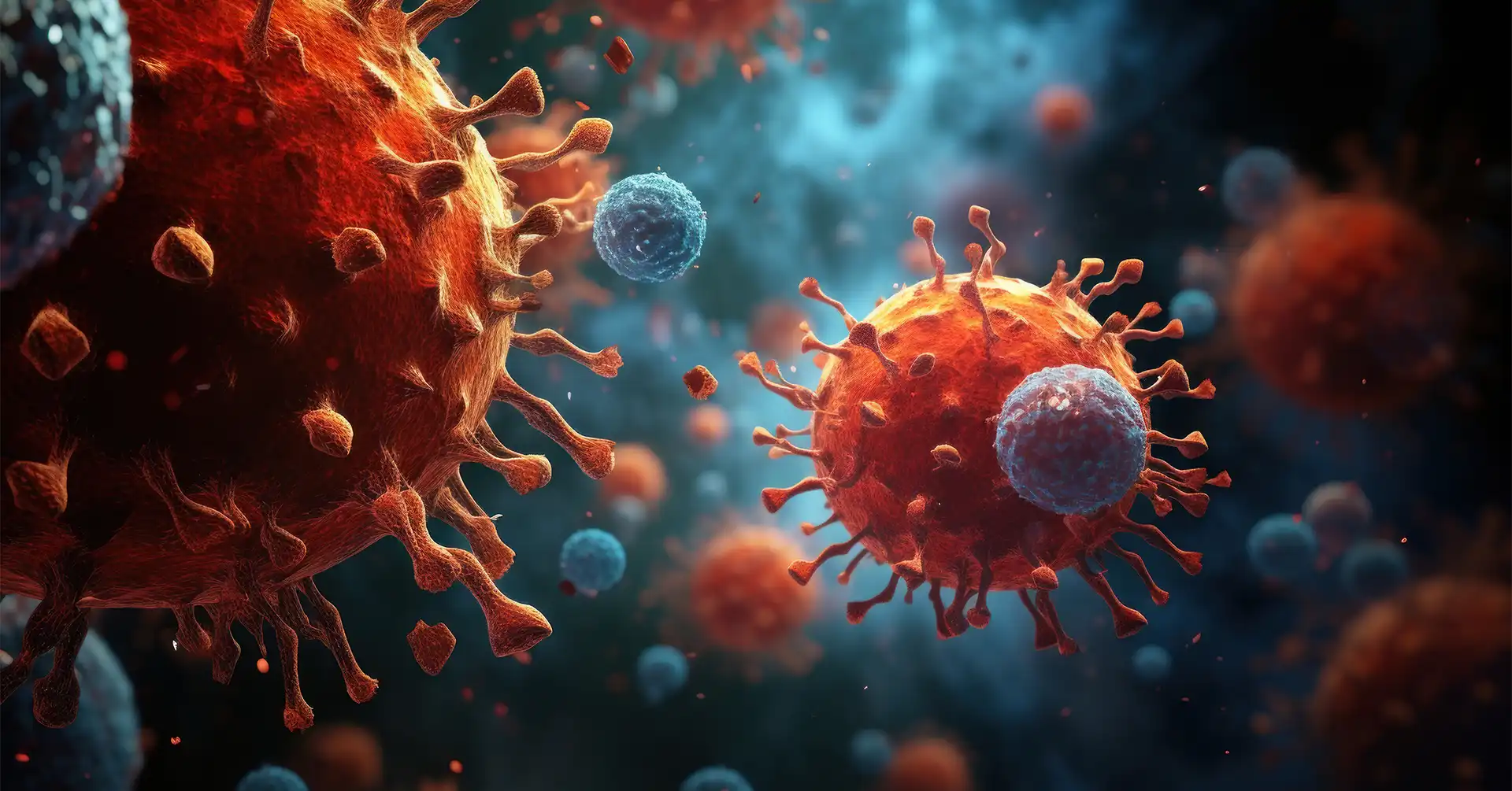In most controversial and hotly debated issues, the question “Are viruses living or nonliving?” tops the list among students and scientists. In basic biology, we define living organisms as those which grow, reproduce, maintain homeostasis, and respond to their environment. Herein, plants, animals, bacteria, and all the traditional examples fit neatly into this definition.
The viruses do not exactly correspond to this pattern. In fact, they lack most of the real features of life. As an illustration, viruses neither grow nor self-reproduce. Instead, to replicate, they hijack the machinery of a host cell. In fact, this dependence on the host for metabolism and reproduction is the reason many experts argue on whether or not viruses are living or nonliving.
In other words, the definition of life has classically included a collection of biological processes that viruses do not possess on their own. In asking then, “are viruses living or nonliving,” we’re setting out the parameters of what constitutes life itself. This is a continuous argument and subject to further changes as science and technology advance.
What is a Living Organism?
First of all, it is essential to provide the definition of “living” if it is to be understood whether viruses are classified as living or not. Generally, living organisms share a few characteristics that help classify them as living and make them distinguished from non-living things.
Cellular Structure: Living organisms all consist of cells. Cells are units of life and possess the ability to execute functions one would identify with an organism, for example, metabolism and reproduction.
Metabolism: The working of living organisms involves chemical reactions. A biochemical process of metabolism makes food change into energy and synthesizes many essential molecules.
Growth and Development: The living organisms grow and develop. Organisms grow in size and complexity. This may sometimes occur according to a specific growth or developmental pattern.
Reproduction: The ability to reproduce is one of the distinguishing characteristics of life. All living organisms can produce offspring. This provides for and supports the continuation of their specific species.
Response to Stimuli: The living organisms respond to any change in the environment. They can react to stimuli like light, temperature and other external factors.
Looking at the characteristics of viruses against this backdrop, when discussing “are viruses living or nonliving,” one would immediately realize that viruses lack cellular structure and metabolic process, just like living organisms. Second, viruses cannot replicate themselves independently without host cells, neither can they grow or develop. It is this very argument perhaps that explains why the debate as to whether a virus is living or nonliving continues to fascinate the scientific fraternity and the general public alike.
Viruses: An Unconventional Entity
Peculiar Biological Properties of Viruses
Viruses are considered to be different from other microorganisms because they don’t typify the conventional definitions of life. Where most other microorganisms are either bacteria or fungi, viruses lack all the basic machinery necessary to carry out life on their own. Their composition includes genetic material—either DNA or RNA—enveloped by a coat of proteins but lacks cells and the capability for performing metabolism independently. This definitely makes the debate of whether viruses are living or nonliving quite interesting. Basically, viruses always stay in that twilight zone between living and nonliving organisms, which most people get away asking, “Are viruses living or nonliving?”
Why Viruses Can’t Fit into the Criteria of Life
One of the reasons for not classifying viruses as living is their lack of self-sufficiency. They can’t reproduce or perform metabolic activities without invading a host cell. In other words, viruses are forced to hijack the cellular machinery of living organisms for replication and transmission. It is precisely this reliance on host cells that allows many scientists to treat viruses as nonliving. Thus, despite the fact that they carry genetic information and evolve over time, they don’t meet the full criteria of life. In doing so, this leads to the perpetual question: “Are viruses living or nonliving?”
Reproduction and Metabolism in Viruses
The virus does not reproduce nor metabolize by itself. Rather, it needs the presence of some host cells to replicate or metabolize. In the process of infecting the cell, a virus inserts its genome into the host and takes over the host machinery to produce new viral particles; this does not involve normal cellular metabolism found in living organisms. Because viruses lack their own systems for metabolism and reproduction, they don’t fit the traditional criteria for life. This brings us back to the question, “Are viruses living or nonliving?”—showing just how special and complicated the nature of these creatures is.
The Role of Host Cells in Viral Activity
How Viruses Depend on Hosts
One of the interesting aspects of viruses, considering the debate of whether they are living or not, is their inability to act on their own independently. They thoroughly rely on host cells to execute the essential life procedures. On entering a host cell, a virus introduces its genetic material into the host cell and takes over its machinery to reproduce. Without a host, a virus can’t grow, reproduce, or perform any activities usually associated with living organisms. That poses a dilemma about if they are living or not since they can’t perform the functions of life by themselves.
Viruses in the Light of Modern Science
The advancement in virology has given excellent depth to our knowledge regarding viruses and their role in proving them either a living or nonliving thing. Modern science finds viruses, though not living organisms, playing a very important role in the ecosystem and human health. For example, viruses modulate the host cell’s genetic material, acting on evolution and occasionally causing certain diseases. Research into viruses has constantly challenged and redefined our understanding of life; it has been one of the most dynamic fields of study.
Virology: Advancements and Their Implications
Recent advances in virology have deepened awareness of the complexities of viruses and how host cells interact with them. Methods such as CRISPR and advanced imaging have given researchers ways to watch the actions of viruses at the molecular level. Such advances, however, bode a potential medicine implication for targeted therapies and vaccines. The more that is learned about the operation of viruses, the better their role in the “are viruses living or nonliving” debate and their relationship with both health and disease can be appreciated.
Public Health Perspectives on Viruses
Whether considered living or nonliving, viruses play a major role in human health. The answer to the question, “are viruses living or nonliving,” is hotly contested among scientists because viruses possess qualities that make it hard to give a line separating living things from the nonliving. They can’t reproduce or carry out metabolic processes on their own; they need a host to do so.
A virus infects the host and takes over the host’s cells to replicate, making the individual unwell in the process. For instance, agents of flu viruses, COVID-19, and other pathogenic viruses disturb normal functions in the body, giving way to symptoms that can be as simple as a cold or serious as respiratory problems. It is important to determine if a virus is considered living or not to help scientists work out the best treatment and prevention methods.
Frequently Asked Questions
What Sets Viruses Apart from Living Organisms?
In many instances, one can hear about viruses in the “are viruses living or nonliving?” debate because they do not correspond to well-known notions of life. In contrast with living organisms, viruses are unable to conduct life processes on their own. They lack apparatuses needed for metabolism and self-replication. That is why they must infiltrate a host cell for replication. They use the apparatus of the host cell for their life cycle, which is why most scientists consider them nonliving organisms.
Why Do Scientists Debate If Viruses Are Living or Nonliving?
The debate “are viruses living or nonliving” rests on their unique features. On one hand, viruses demonstrate certain properties of living organisms, for example, the ability to evolve and adapt. On the other hand, they don’t have cell structure or metabolic processes that happen independently. This very duality in their nature brings different interpretations by scientists. Some consider them a form of life since they are capable of infecting and replicating in host cells; however, the fact that they lack independence and metabolic activity makes others consider them not living.
How do viruses reproduce if they aren’t alive?
Though viruses do not appear as living, they are known to reproduce, again leaving the questions “are viruses living or nonliving?” They reproduce by hijacking host cell machinery. They hijack cellular machinery once inside the cell to produce their own copies. Such a process does not consist of metabolic activity or cellular function, which helps to reaffirm that they exist in that gray area between living and nonliving.
What Role do Host Cells Play in Viral Activity?
As stated earlier, host cells are essential for viruses, hence the discussion of “are viruses living or nonliving?” Without a host cell, it cannot reproduce or conduct any life-sustaining activity. They rely solely on host cells to replicate and spread. This dependence identifies them as non-living since they cannot conduct these functions independently.
How Does Understanding Viruses Affect Public Health?
Knowing the nature of viruses as probably nonliving makes a lot of difference in designing public health strategies. Emphasizing the question, “Are viruses living or nonliving?” will help scientists and health professionals in the design of treatments and preventive measures. Knowing the requirement of hosts by viruses to replicate dictates ways of controlling their spread, vaccine development, and antiviral drugs. This knowledge is cardinal in the management of viral infections and protection of public health.
Conclusion
The question “are viruses living or nonliving” epitomizes the complexity involved in classifying these unique entities. The viruses are living entities showing the two fundamental characteristics—evolution and replication—but lack other important features such as self-reliant metabolism and cellular structure, which makes many scientists regard it as nonliving. Knowing this makes all the difference in planning robust public health strategies and medication since it equips us with the abilities to deal with challenges from viral infections and advances in virology.
Also Read:
Make a Great Website: Tips and Tricks!
The Dangers of Doing Too Much: Mental & Physical Health Impacts






